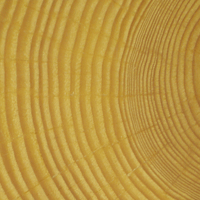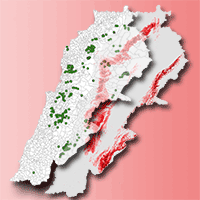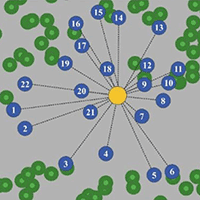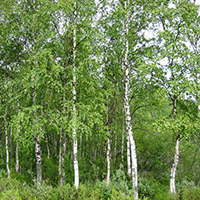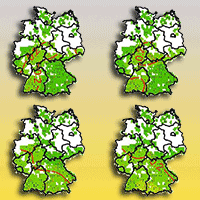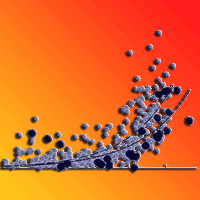The aim of this study is to examine the effect of individual canopy tree on the species composition and abundance of understorey vegetation in subtropical forests, by applying a model for tree influence on understorey vegetation of boreal spruce forests developed by Økland et al. (1999), according to the principles of Ecological Field Theory (EFT). The study was based upon five vegetation data sets, each with two subsets (vascular plants species and bryophytes species) from subtropical forests in south and southwest China. Optimal value of tree influence model parameters was found by maximizing the eigenvalue of a Constrained Ordination (CO) axis, obtained by use of the EFT-based tree influence index as the only constraining variable. One CO method, Redundancy Analysis (RDA), was applied to five vegetation data sets. The results showed that the optimal EFT tree influence models generally accounted for only a small part of the variation in species composition (the eigenvalues of RDA axes were low, amounted to 1-10% of total inertia). The higher eigenvalue-tototal-inertia ratio with RDA was interpreted as due mainly to the low species turnover along the tree influence gradient. Vascular plants and bryophytes species differed with respect to optimal parameters in the tree influence model, especially in a conifer dominated forest. Compositional turnover associated with tree influence indices was also generally low, although somewhat varies among study areas. Thus, it was concluded that single-tree EFT models may have limited suitability for studied subtropical forests; different optimal parameters in the tree influence model obtained for vascular plants and bryophytes species in two studied areas indicates that subtropical trees may impact vascular plants and bryophytes species in different ways; and trees may influence the understorey species composition more in a collective manner than through the influence of single individuals in studied subtropical forests.
Keywords
, , , , ,
Citation
Liu H-Y, Halvorsen R (2012). Single-tree influence on understorey vegetation in five Chinese subtropical forests. iForest 5: 179-187. - doi: 10.3832/ifor0623-005
Academic Editor
Renzo Motta
Paper history
Received: Oct 24, 2011
Accepted: Jun 30, 2012
First online: Aug 02, 2012
Publication Date: Aug 29, 2012
Publication Time: 1.10 months
© SISEF - The Italian Society of Silviculture and Forest Ecology 2012
Open Access
This article is distributed under the terms of the Creative Commons Attribution-Non Commercial 4.0 International (https://creativecommons.org/licenses/by-nc/4.0/), which permits unrestricted use, distribution, and reproduction in any medium, provided you give appropriate credit to the original author(s) and the source, provide a link to the Creative Commons license, and indicate if changes were made.

Breakdown by View Type
(Waiting for server response...)
Article Usage
Total Article Views: 57138
(from publication date up to now)
Breakdown by View Type
HTML Page Views: 47205
Abstract Page Views: 3597
PDF Downloads: 4991
Citation/Reference Downloads: 19
XML Downloads: 1326
Web Metrics
Days since publication: 4882
Overall contacts: 57138
Avg. contacts per week: 81.93
Article Citations
Article citations are based on data periodically collected from the Clarivate Web of Science web site
(last update: Mar 2025)
Total number of cites (since 2012): 2
Average cites per year: 0.14
Publication Metrics
by Dimensions ©
Articles citing this article
List of the papers citing this article based on CrossRef Cited-by.
(1)
Aude E, Lawesson JE (1998)Vegetation in Danish beech forests: the importance of soil, microclimate and management factors, evaluated by variation partitioning. Plant Ecology 134: 53-65.
CrossRef |
Gscholar
(2)
Barbier S, Gosselin F, Balandier P (2008)Influence of tree species on understory vegetation diversity and mechanisms involved-A critical review for temperate and boreal forests. Forest Ecology and Management 254:1-15.
CrossRef |
Gscholar
(3)
Berger AL, Puettmann KJ (2000)Overstory composition and stand structure influence Herbaceous plant diversity in the mixed Aspen forest of Northern Minnesota. American Midland Naturalist 143: 111-125.
CrossRef |
Gscholar
(4)
Borcard D, Legendre P, Drapeau P (1992)Partialling out the spatial component of ecological variation. Ecology 73: 1045-1055.
CrossRef |
Gscholar
(5)
Chen ZS, Hsieh CF, Jiang FY, Hsieh TH, Sun IF (1997)Relations of soil properties to topography and vegetation in a subtropical rain forest in southern Taiwan. Plant Ecology 132: 229-241.
CrossRef |
Gscholar
(6)
Chávez V, Macdonald SE (2010)The influence of canopy patch mosaics on understory plant community composition in boreal mixed wood forest. Forest Ecology and Management 259: 1067-1075.
CrossRef |
Gscholar
(7)
Denslow JS, Ellison AM, Sanford RE (1998)Treefall gap size effects on above and belowground processes in a tropical wet forest. Journal of Ecology 86: 597-609.
CrossRef |
Gscholar
(8)
Eilertsen O, Økland RH, Økland T, Pedersen O (1990)Data manipulation and gradient length estimation in DCA ordination. Journal of Vegetation Science 1: 261-270.
CrossRef |
Gscholar
(9)
Enoki T, Abe A (2004)Saplings distribution in relation to topography and canopy openness in an evergreen broad-leave forest. Plant Ecology 173: 283-291.
CrossRef |
Gscholar
(10)
Felton A, Felton AM, Wood J, Lindenmayer DB (2006)Vegetation structure, phenology, and regeneration in the natural and anthropogenic tree-fall gaps of a reduced-impact logged subtropical Bolivian forest. Forest Ecology and Management 235: 186-193.
CrossRef |
Gscholar
(11)
Francois LM, Ghislain M, Otto D, Micheels A (2006)Late Miocene vegetation reconstruction with the CARAIB model. Palaeogeography, Palaeoclimatology, Palaeoecology 238: 302-320.
CrossRef |
Gscholar
(12)
Giesler R, Högberg M, Högberg P (1998)Soil chemistry and plants in Fennoscandian boreal forest as exemplified by a local gradient. Ecology 79: 119-137.
CrossRef |
Gscholar
(13)
Hanley TA, Brady WW (1997)Understorey species composition and production in old-growth western hemlock - Sitka spruce forests of southeastern Alaska. Canadian Journal of Botany 75: 574-580.
CrossRef |
Gscholar
(14)
Greenacre MJ (1984)Theory and applications of correspondence analysis. Academic Press, London, UK.
Gscholar
(15)
Kuuluvainen T (1994)Gap disturbance, ground microtopography, and the regeneration dynamics of boreal conifer forests in Finland: a review. Annales Zoologici Fennici 31: 35-51.
Gscholar
(16)
Kuuluvainen T, Hokkanen TJ, Järvinen E, Pukkala T (1993)Factors related to seedling growth in a boreal Scots pine stand: a spatial analysis of a vegetation soil system. Canadian Journal of Forest Research 23: 2101-2109.
CrossRef |
Gscholar
(17)
Kuuluvainen T, Pukkala T (1989)Effect of Scots pine seed trees on the density of ground vegetation and tree seedlings. Silva Fennica 23: 159-167.
Gscholar
(18)
Laughlin DC, Abella SR (2007)Abiotic and biotic factors explain independent gradients of plant community composition in ponderosa pine forests. Ecological Modelling 205: 231-240.
CrossRef |
Gscholar
(19)
Legendre P, Legendre L (1998)Numerical Ecology. Elsevier Science, Amsterdam, The Netherlands.
Gscholar
(20)
Liu HY, Økland T, Økland RH, Gao JX, Liu QR, Eilertsen O, Bratli H (2008)Gradient analyses of forests ground vegetation and its relationships to environmental variables in five subtropical forest areas, S and SW China. Sommerfeltia 32: 1-196.
CrossRef |
Gscholar
(21)
Maltez-Mouro S, Garcia LV, Maranon T, Freitas H (2005)The combined role of topography and overstorey tree composition in promoting edaphic and floristic variation in a Mediterranean forest. Ecological Research 20: 668-677.
CrossRef |
Gscholar
(22)
Michalet R, Rolland Ch, Joud D, Gafta D, Callaway RM (2002)Associations between canopy and understory species increase along a rain shadow gradient in the Alps: habitat heterogeneity or facilitation? Plant Ecology 165: 145-160.
CrossRef |
Gscholar
(23)
Nesheim I, Økland RH (2007)Do vine species in neotropical forests see the forest or the trees? Journal of Vegetation Science 18: 395-404.
CrossRef |
Gscholar
(24)
Økland RH (1990)Vegetation ecology: theory, methods and applications with reference to Fennoscandia. Sommerfeltia Supplement 1: 1-233.
Gscholar
(25)
Økland RH (1999)On the variation explained by ordination and constrained ordination axes. Journal of Vegetation Science 10: 131-136.
CrossRef |
Gscholar
(26)
Økland RH, Eilertsen O (1993)Vegetation-environment relationships of boreal conifer forests in the Solhomfjell area, Gjerstad, S Norway. Sommerfeltia 16: 1-254.
Gscholar
(27)
Økland RH, Eilertsen O (1994)Canonical correspondence analysis with variation partitioning: some comments and an application. Journal of Vegetation Science 5: 117-126.
CrossRef |
Gscholar
(28)
Økland RH, Rydgren K, Økland T (1999)Single-tree influence on understorey vegetation in a Norwegian boreal spruce forest. Oikos 87: 488-498.
CrossRef |
Gscholar
(29)
Økland T (1988)An ecological approach to the investigation of a beech forest in Vestfold, SE Norway. Nordic Journal of Botany 8: 375-407
CrossRef |
Gscholar
(30)
Økland T (1996)Vegetation-environment relationships of boreal spruce forests in ten monitoring reference areas in Norway. Sommerfeltia 22: 1-349.
Gscholar
(31)
Oksanen J (2010)Multivariate analysis of ecological communities in R: vegan tutorial.
Online |
Gscholar
(32)
Ozaki K, Ohsawa M (1995)Successional change of forest pattern along topographical gradients in warm-temperate mixed forests in Mt Kiyosumi, central Japan. Ecological Research 10: 223-234.
CrossRef |
Gscholar
(33)
Pukkala T, Kuuluvainen T, Stenberg P (1993)Below-canopy distribution of photosynthetically active radiation and its relation to seedling growth in a boreal Scots pine stand: a simulation approach. Scandinavian Journal of Forest Research 8: 313-325.
CrossRef |
Gscholar
(34)
Rao CR (1964)The use and interpretation of principal components analysis in applied research. Sankhya Serie A, 26: 329-358.
Gscholar
(35)
Rydgren K (1994)Low-alpine vegetation in Gutulia National Park, Engerdal, Hedmark, Norway, and its relation to the environment. Sommerfeltia 21: 1-47.
Gscholar
(36)
Sayer EJ (2007)Using experimental manipulation to assess the roles of leaf litter in the functioning of forest ecosystems. Biological Reviews 81:1-31.
CrossRef |
Gscholar
(37)
Sokal RR, Rohlf FJ (1995)Biometry. Freeman, New York, USA.
Gscholar
(38)
Sterck FJ, Clark DB, Clark DA, Bongers F (1999)Light fluctuations, crown traits, and response delays for tree saplings in a Costa Rican lowland rain forest. Journal of Tropical Ecology 15: 83-95.
CrossRef |
Gscholar
(39)
Strong WL (2011)Tree canopy effects on understory species abundance in high-latitude
Populus tremuloides stands, Yukon, Canada. Community Ecology 12: 89-98.
CrossRef |
Gscholar
(40)
Svenning J (1999)Microhabitat specialization in a species-rich palm community in Amazonian Ecuador. Journal of Ecology 87: 55-65.
CrossRef |
Gscholar
(41)
ter Braak CJF (1986)Canonical correspondence analysis: a new eigenvector technique for multivariate direct gradient analysis. Ecology 67: 1167-1179.
CrossRef |
Gscholar
(42)
ter Braak CJF (1987)The analysis of vegetation-environment relationships by canonical correspondence analysis. Vegetatio 69: 69-77.
CrossRef |
Gscholar
(43)
ter Braak CJF, Prentice IC (1988)A theory of gradient analysis. Advances in Ecological Research18: 271-317.
CrossRef |
Gscholar
(44)
ter Braak CJF, Wiertz J (1994)On the statistical analysis of vegetation change: a wetland affected by water extraction and soil acidification. Journal of Vegetation Science 5: 361-372.
CrossRef |
Gscholar
(45)
Thomsen RP, Svenning J-C, Balslev H (2005)Overstorey control of understorey species composition in a near-natural temperate broadleaved forest in Denmark. Plant Ecology 181: 113-126.
CrossRef |
Gscholar
(46)
Tuomisto H, Ruokolainen K, Kalliola R, Liina A, Danjoy W, Rodriguez Z (1995)Dissecting Amazonian biodiversity. Science 269: 63-66
CrossRef |
Gscholar
(47)
Walker J, Sharpe PJH, Penridge LK, Wu H (1989)Ecological field theory: the concept and field tests. Vegetatio 83: 81-95.
CrossRef |
Gscholar
(48)
Wilczynski CJ, Pickett STA (1993)Fine root biomass within experimental canopy gaps: evidence for a below-ground gap. Journal of Vegetation Science 4: 571-574.
CrossRef |
Gscholar
(49)
Wu H, Sharp PJH, Walker J, Penridge LK (1985)Ecological field theory: a spatial analysis of resource interference among plants. Ecological Modelling 29: 215-243.
CrossRef |
Gscholar
(50)
Xiong YM, Xia HP, Li ZA, Cai XA, Fu SL (2008)Impacts of litter and understory removal on soil properties in a subtropical
Acacia mangium plantation in China. Plant Soil 304:179-188.
CrossRef |
Gscholar
(51)
Zhang LW, Mi XC, Shao HB, Ma KP (2011)Strong plant-soil associations in a heterogeneous subtropical broad-leaved forest. Plant and soil. -
CrossRef |
Gscholar
(52)
Zhao CM, Chen WL, Tian ZQ, Xie ZQ (2005)Altitudinal pattern of plant species diversity in Shennongjia Mountains, central China. Journal of Integrative Plant Biology 47: 1431-1449.
CrossRef |
Gscholar



